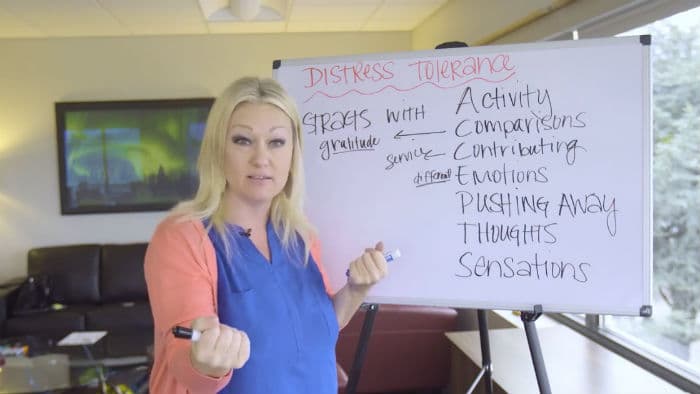My name is Nicole and I am the Program Coordinator at New Roads Residential Treatment Center. I also do the DBT skills training with the clients.
Today we are going to learn a skill. It is in our distress tolerance skill set. I’m gonna write distress tolerance down.
Steps for Distress Tolerance
Now, we use distress tolerance, usually, when we’re in some kind of crisis. Acting on those crisis urges will make the situation worse.
One of the ways we can do this is by distracting. We use a little acronym. We call it distracts with, and we use this acronyms ACCEPTS.
Within this ACCEPTS we have seven … one, two, three, four, five, six, seven different things that we can do to distract from our elevated emotions.
1. Activities
The first thing that we try to do is activities.
Let’s say we are getting elevated, we’re upset, we feel like we’re gonna just leave the facility and not come back, we know that that’s gonna make whatever situation’s going on worse.
We wanna find a different activity to not replace the emotion, but take us away from the emotion.
Some of the things we do at the facility is, “Hey, do you wanna go out and play basketball, shoot some hoops? Why don’t you go play pool with so and so?”
Volleyball’s big now that the weather’s gotten nice, go on a walk, just different activities. A lot of people like to color, play cards.
Playing cards is a big one. Activities can distract from the distress that the client is in.
2.Comparisons
The second one, the first C, second skill, is comparisons. This is pretty self explanatory.
I like to call it gratitude.
I’ll often tell the clients, “Go make a gratitude list. What are you grateful for?” What happens is they start to write these things down and they start to see that things aren’t so bad.
Or, they can just say to themselves, “Hey, I’m in a way better place than I was,” say, “a year ago. A year ago I was living on the streets.”
Or, “This is a way better place and I’ve grown so much.” Looking at what their life was like and … compared to what it’s like now, or, even just other people’s everyday problems.
I have a friend and her husband just died and she has four kids. She doesn’t have a job. She has all this stress.
You can see that and see that you don’t have those things to worry about. That is comparisons.
3. Contributing
The next C is my very favorite. It is contributing, which I let the client’s know this is service.
Be of service to your peers, someone around you. I’ll often have the clients, after I teach this skill, I have them draw names secretly.
They have to do a random act of kindness for that person. It can be as simple as, oh, go and making their bed for them or doing their daily chore for them, or getting them a snack from the store.
Contributing to your peers, or your fellow man, just helping someone else out, for some reason, really takes your mind off of what you’re going through and your emotions.
4. Emotions
The next one is, I just said it, emotions.
We want to distract with different emotions. I’m gonna put different right here so it makes more sense. We’re distracting with different emotions.
This means, say you’re feeling depressed and you can’t seem to get out of this depression.
Activity’s a really good one for that, too, but you can’t get out of this depression.
Think of the funniest movie that you know and love and go watch that hilarious movie.
You’re probably not gonna want to go watch Fight Club if you’re angry. You can just find something that’s funny that will make you happy to change your emotions.
Happy music, upbeat music, that can also help.
5. Pushing Away
The P in ACCEPTS stands for pushing away.
I like to call this put it up on a shelf, just for a little bit, ’cause we do need to deal with our emotions. Just for a little bit you can put this up on a shelf, take it back down, and look at it later.
Say, “Why did this make me upset? What was going on with it?”
The client’s always tell me, “Well, that’s easier said than done.”
Absolutely. I agree, but everything in these skills takes practice.
It’s practice, practice, practice, asking yourself, “What skill can I use in this situation?” Pushing away, or putting it up on the shelf, take a look at it later.
Remove yourself physically from the situation if you have to.
6. Thoughts
The T stands for different thoughts. The example I use here is, say you’re sitting in a boring class and the person next to you is really agitating you by crunching chips or ice or whatever.
You feel yourself getting elevated and agitated and you just wanna get up and walk out, but you’ve gotta be in this class.
One thing I tell them is count the ceiling tiles. I looked up at the ceiling tiles.
Count the ceiling tiles. Repeat the words of your favorite song in your head.
Just trying to get your thoughts off what the person next to you’s doing or what is making your emotions elevated.
7. Sensations
The final one is sensations.
You’ll hear a lot about sensations in distress tolerance. You want to make your body feel something different.
Listening to really loud music will help. Holding a piece of ice, you just wanna have different sensations and it usually will take your mind off of what is causing the distress.
That is the distress tolerance skill of distracts with ACCEPTS.

